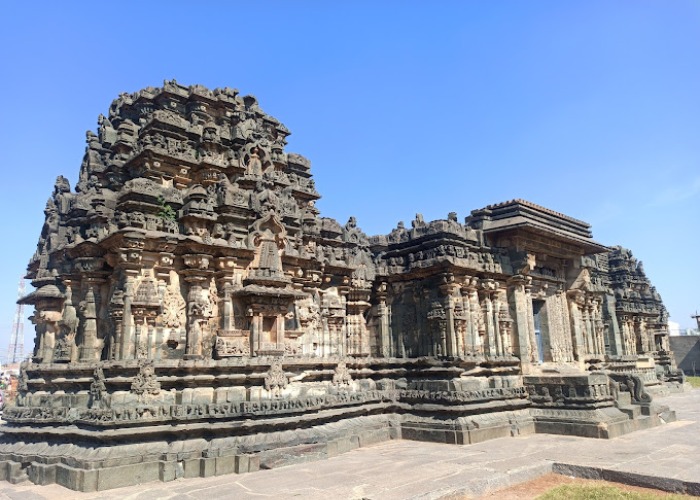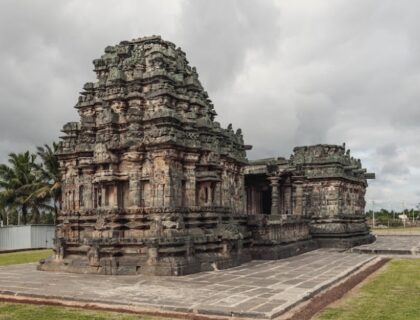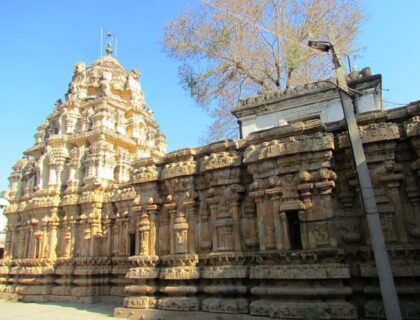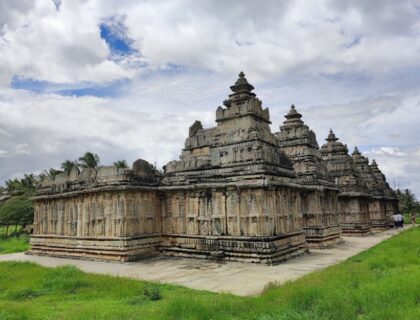Kashi Vishveshwara Temple Lakkundi
The Kashi Vishveshwara Temple also known as the Kavatalesvara or Kashi Vishwanath Temple of Lakkundi, is located in the Gadag district of Karnataka, India. Kashi Vishveshwara Temple is a prime example of the fully developed Kalyana Chalukya style of Hindu architecture. Lakkundi is known for various Hindu temples mainly Chalukyas. The city was developed during the era of Chalukyas.
The Kashi Vishveshwara Temple features two sanctums that face each other and share a mandapa. The larger sanctum is dedicated to Lord Shiva, while the smaller temple is dedicated to Surya Dev. The temple is notable not only for its three-dimensional miniature reliefs and fine artwork details, but also for incorporating all three major styles of Hindu temple architecture – the Nagara, Vesara, and Dravida.
Kashi Vishveshwara Temple in Lakkundi is about 12 kilometres from Gadag-Betageri, a twin city located between Hampi and Goa and connected by India’s National Highway 67. Lakkundi, home to numerous ruins of historic Hindu and Jain temples, is geographically located in a region with many major temple groups from the Kalachuris, Chalukyas, Yadavas-Seunas, Hoysalas, and Vijayanagara eras.
Significance of Kashi Vishveshwara Temple Lakkundi
This rare twin temple shares a mandapa with the Kashi Vishweshwara Temple to the east and the Suryanarayana Temple to the west. Though the Kashi Vishweshwara Temple is widely regarded as the greatest edifice of its time, the Suryanarayana Temple is equally beautiful.

The most striking feature of this temple is the five-tiered lintel above the entrance doorway, which is intricately carved with repetitive motifs, sculptures, patterns, and figures within the auspicious foliage design. The lintel is adorned with a magnificent sculpture of Gajalakshmi, flanked by elephants.
History of Kashi Vishveshwara Temple Lakkundi
Built by the Chalukyas in 1087 CE, it is one of the most ornate temples, with intricately carved elements. In front of this temple is the Nannesvara Temple, an 11th-century Hindu temple.

The presence of a 1087 CE inscription on a beam in the Kashi Vishveshwara Temple Mantapa (hall), as well as the plainness of that part of the temple, suggest that the original construction was simpler and that the profusion of decoration was added to the other parts of the temple later after Chola invasions of Chalukyan territory ended. The majority of the inscriptions in Lakkundi date from 1170 CE onwards.

It is known that Hoysala king Veera Ballala II annexed Lakkundi (also known as Lokkigundi) from the Seunas of Devagiri and established it as his capital around 1193 CE. It is possible that the temple underwent renovations during his rule.
The Architecture of Kashi Vishveshwara Temple Lakkundi
The Kashi Vishveshwara Temple Lakkundi has a unique layout with Lord Shiva in the east, and Suryanarayana in the west. The Shiva linga is about three feet high from the sanctum, and unlike other Sun temples, the Sun God faces west. The temple’s stone plans are much sharper and crisper, with perfect light and dark shades in the stonework. The arches, mouldings, lintels, and door jambs are richly carved, capturing the exemplary architecture of the Chalukyan era.
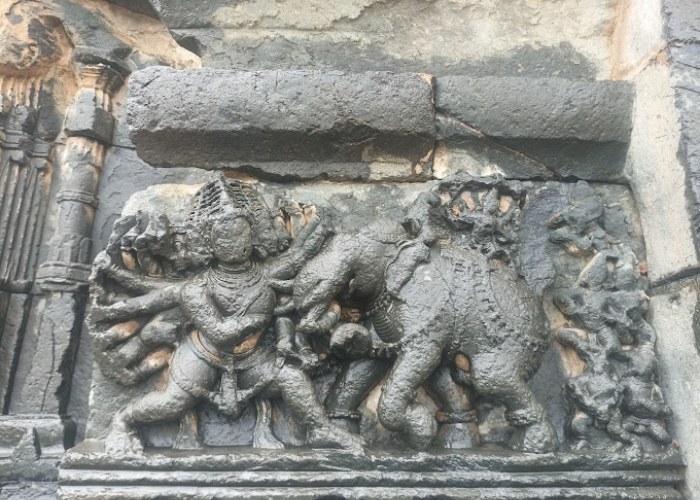
The temple also has some mini towers that were Shrines or deities, demonstrating the influence of architecture in northern India. The doorstep mouldings and doorways contain exquisite works of art and presentations that will keep art lovers busy. The pillars contain many sculptures and artworks of different gods and characters from Hinduism.

The walls feature images of Lakshmi and Vishnu. The dedicatory block on the lintel features an image of Gajalakshmi and elephants. The temple lacks a kalasha, the finishing capping structure, but it does contain work that is representative of expert craftsmanship. The polished pillars and shafts are truly elegant works of art.

The walls and pillars are elaborately decorated, and the slabs of the windows show off the Chalukyas’ craftsmanship. The intricate architectural designs are excellent additions to the temple. The ceilings also bear inscriptions from the Vijayanagara Empire era. The decorative carvings reflect South Indian architecture, while the overall structure is more Northern in style. The towers have decorative works, including several niches.
Important Facts About Kashi Vishveshwara Temple Lakkundi
- The Kashi Vishveshwara Temple is located in the southern part of Lakkundi, directly east of the Nannesvara Temple. It is located approximately 12 kilometres southeast of the Gadag-Betageri twin city, between Hampi and Goa.
- Lakkundi is a small, village-like town. Before the 14th century, Lakkundi was a large, historic city known as Lokkigundi in pre-14th century texts and inscriptions, and it served as the Hoysala dynasty’s capital.
- The Dwikuta (two shrines) temple has Kashi Vishveshwara linga facing east and Surya dev (Sun God) facing west, which is unusual for Surya temples.
- The most striking feature of this Kashi Vishveshwara Temple is the five-tiered lintel above the entrance doorway, which is intricately carved with repetitive motifs, sculptures, patterns, and figures within the auspicious foliage design.
- The lintel of Kashi Vishveshwara Temple is adorned with a magnificent sculpture of Gajalakshmi, flanked by elephants.
- The Kashi Vishveshwara Temple illustrates Chalukyan’s artistic achievements, particularly in its use of light and shade.
- Mouldings, arches, internal and external walls, shikhara (tower), doorjambs, and lintels are all decorated with intricate carvings and ornamentation.
- The Kashi Vishveshwara Temple in Lakkundi is a shining example of Chalukya’s architectural genius and artistic expression.
- The Kashi Vishveshwara Temple, like many historical structures of great significance, has weathered the test of time and environmental conditions.
- It is an important heritage site that requires ongoing conservation efforts to maintain its structural integrity and artistic charm.
- The Archaeological Survey of India recognises the temple’s historical significance and has worked to preserve and restore the site for future generations.
Best Time to Visit Kashi Vishveshwara Temple Lakkundi
This place is very heavenly and spiritual, and you can visit it all year. The best time to visit this temple, however, is during the monsoon and winter seasons. During the monsoon season, this location receives moderate to heavy rainfall, making it appear heavenly with its greenery and bringing freshness elsewhere.
Famous Festivals In Kashi Vishveshwara Temple Lakkundi
- Shravana: For happiness and wealth, many fasts, offerings, and mantras are performed during the fifth month of the Hindu calendar, known as Shravana.
- Mahashivaratri is a fasting ritual that takes place in the last week of February. It is reminiscent of Lord Shiva bringing Goddess Parvati with him. A Grand Celebration is arranged by priests and the temple committee.
How to Reach Kashi Vishveshwara Temple Lakkundi
By Air: The Hubbali airport is approximately 75 kilometres from the Kashi Vishveshwara Temple. To get to the temple, take a state bus, a private bus, or a private taxi from the airport.
By Rail: The closest railway station is Gadag Junction. From here, a private taxi or bus can transport you to the Kashi Vishveshwara Temple, which is 25 kilometres away.
By Road: Lakkundi village is well connected to other towns and cities in the Gadag district via roads. The closest town is Mmulgund, which is 45 kilometres away.
Also Read – Amruteshvara Temple Amruthapura
Support Us
If our content helps you even 1% in gaining information about the temple, please support us by contributing any amount, our UPI ID is - q417999792@ybl Or pay using QR CODE >>> Click Now
Location
Facilities
- Drinking Water
- Pooja Item Shops
- Prasad Shops
- Restaurants Nearby
- Resting Room















